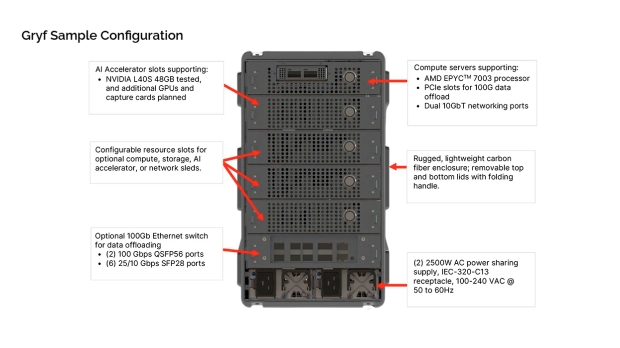GigaIO and SourceCode have just unveiled Gryf, an ultra-portable AI supercomputer-class system that weighs less than 55 pounds, and fits inside of a TSA-friendly carry-on suitcase. Impressive.

VIEW GALLERY – 3 IMAGES
Gryf can handle data collection and processing on a scale that would usually see the data sent off-site, this means that the suitcase-sized supercomputer handles super-fast processing and analysis, all in a suitcase. Gryf supports disaggregating and reaggregating its GPUs, with owners capable of customizing the system’s hardware configuration in the field, and on-the-fly.
You can create the absolute optimal hardware configuration for one assigned workload, and then the next workload gets another optimized hardware configuration. Each Gryf has multiple slots filled with compute, storage, accelerator, and network sleds that are perfect for their respective workloads. There’s 6 sled slots in total, where you can insert and remove the modules as required.
If you were running AI or ML workloads, you would probably want to use two compute sleds, an accelerator sled, two storage sleds, and a network sled. But, for a storage-related project, you’d change to one compute sled, and five storage sleds for a total of 246TB of SSD storage.

The compute sled features an AMD EPYC 7313 CPU with 16 cores and 32 threads at up to 3.7GHz with a 155W TDP. There’s 256GB of DDR4-3200 (4 x 64GB sticks) and a 512GB NVMe M.2 SSD. The storage sled features 8 x 30TB NVMe-E1.L SSDs for a total of 246TB of SSD storage, while the network sled features 2 x 100GbE and 6 x 25GbE ethernet connections.
Gryf highlights:
- A singular, composable solution for a diverse set of mission needs. Gryf offers a single, adaptable solution for a variety of applications, ensuring users can meet changing field requirements. Fully configurable on-demand through software or by interchanging sleds, Gryf allows for dynamic reconfiguration, resulting in higher resource utilization, reduced hardware costs, higher availability, and lower power consumption.
- Maximum compute density for unparalleled AI performance at the tactical edge. Gryf sets a new standard for compute density in a portable format. By overcoming traditional cooling challenges through disaggregating power-hungry GPUs and providing for its own ventilation, Gryf is able to combine high-performance GPUs with substantial storage capacity (up to a petabyte) to allow users to execute complex AI tasks more quickly and effectively, directly at the operational site. Each Gryf chassis can accommodate a mix of six compute, accelerator, storage, or network sleds.
- Easily scale to meet diverse mission demands and boost operational responsiveness. Up to five Gryf units can be seamlessly interconnected using GigaIO’s FabreX AI memory fabric for processing of petabyte-size data sets. This configuration allows each Gryf unit to access and share sled components across all five connected chassis in an all-to-all topology.
- Easily transportable for field-missions. Designed for true mobility, Gryf features a rugged, roll-on TSA-friendly form factor that fits into an overhead bin to allow for deployment at any location.
Alan Benjamin, CEO of GigaIO, said: “With AI becoming more pervasive, there is a growing segment of the edge market clamoring for a meaningful amount of accelerated compute locally. This is true for our Department of Defense customers, who have emphasized the critical need for timely and actionable intelligence in the field. Gryf’s novel architecture, made possible by FabreX, our AI memory fabric, provides those customers the advanced compute, storage, and GPU capabilities they crave in today’s sensor-rich edge environments“.